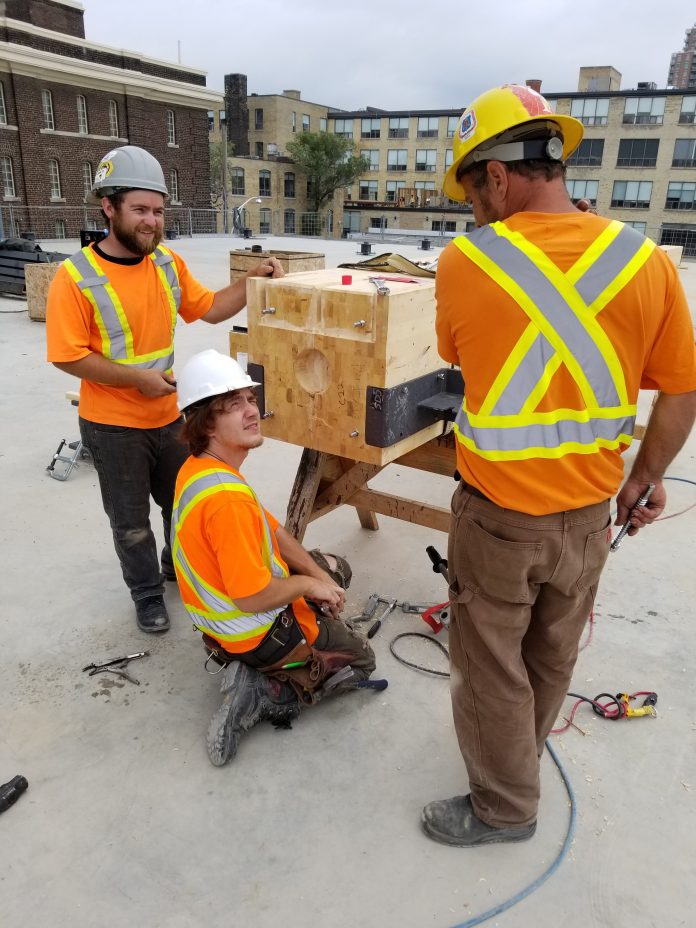Mass timber construction is catching on in Ontario and across Canada and the College of Carpenters and Allied Trades (CCAT) in Woodbridge is leading the way, preparing students to work in the exciting new field.
Students in the four-week course use full-scale building modules as a learning medium at the College of Carpenters and Allied Trades (CCAT) in Woodbridge. Covered is everything from the how-to’s of timber framing tools and fastening systems to methods of installing prefabricated cross-laminated timber (CLT) walls, floor slabs and columns.
It’s a practical program that continually evolves as the industry, and the world, changes. Adapting and leading in a post-COVID-19 industry is a great example of the evolution.
“We believe that post-COVID we need to support Canadian resources more than ever,” said Mike Yorke, president, Carpenters District Council of Ontario.
“Manufacturing and the mass timber sector can address those needs and create economic diversity and prosperity in smaller communities in Ontario and across Canada. With major urban centres promoting the growth in use of mass timber there is a cool symbiotic relationship between larger and smaller communities in this country worth exploring.”
The carpenters’ union is always looking for and responding to trends in the construction industry and Yorke says that with human and natural resources in abundance in Ontario, “there is no reason for us to follow, because we should be a world leader in this sector.”
This year CCAT has experienced greater engagement from the cladding industry, working to prepare students to understand and install non-combustible cladding on wood structures.
Mass timber differs in many ways from traditional construction, making faster on-site installation possible and immediate use of trailing floors.
“It makes greater use of pre-fab and modular components, and the main building materials are grown right here in Canadian forests,” Yorke said. “This has a positive impact on the Canadian economy as the supply chain is local – so we have an opportunity to develop a home-grown product for the global market.”
Timber construction also allows other trades such as HVAC and electrical to jump in immediately behind in the sequence of construction. It’s quieter construction and creates much less on-site waste – meaning less truck traffic. Mass timber as a 100 per cent renewable resource sequesters carbon in the buildings structure and can mitigate the rate of Global Warming. The biophilic design benefits are also a consideration due to the positive impact on human well being of natural wood products as exposed structural elements.
These are just some of the reasons that mass timber is catching on in the GTA, Ontario and even across the country.
“I would say yes, it has caught on, primarily in the public sector currently, with many colleges, community centres and other public buildings underway or in the planning pipeline,” Yorke said.
Unfortunately, in Ontario there is a lack of local supply chain for CLT and other forms of mass Timber and this creates a drag on the sectors competitiveness.
In Quebec and B.C., both jurisdictions where the forestry sector has solid government support, it’s a different story.
“Mass timber is used extensively in multiple sectors of construction such as ICI and residential,” Yorke explained. “Those provinces are following the example of Austria and Italy, the global leaders in Mass Timber where the supply chain for timber products and secondary manufacturing has really been fine tuned.”
Yorke and his colleagues at CCAT are proud of the Mass Timber training courses they offer to carpenters.
“What we are doing is certainly unique in Ontario and Canada as this sector has evolved so quickly,” he said. “Maybe many industry folks saw it as just another ‘post and beam’, but its so much more and evolving rapidly.”
The union’s contracts and contacts with hundreds of builders, clients and contractors provide valuable feedback and CCAT responds quickly to identify needs in training.
“We did not create the program on our own, but in collaboration with some of the leading architects, structural engineers and product suppliers from the sector,” Yorke said.
In addition, some instructors have left the CCAT to engage in onsite construction
Mass Timber, practicing first-hand the skills they need to transfer to apprentices.
“Our commitments and contacts, are, I believe the advantages that set us apart from the crowd and result in an extremely high level of training for our students,” Yorke concluded.
The CCAT delivers real world learning – construction skills courses under site simulated conditions in state-of-the-art facilities.
For more information about Mass Timber courses or other training opportunities, visit CCAT.ca and Masstimbertoday.com

